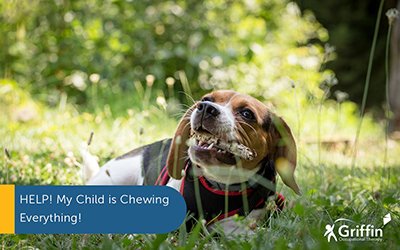Sensory chew toys – which one to choose?
Choosing sensory chew toys for children can be a daunting task. There are so many different ones available! They come in different shapes, different textures, and different colours. In this post we hope to help you make sense of them and to understand which one might be best for your child. We will cover

Sensory chew toys – which one to choose?
Choosing sensory chew toys for children can be a daunting task. There are so many different ones available! They come in different shapes, different textures, and different colours. In this post we hope to help you make sense of them and to understand which one might be best for your child. We will cover
Some children chew all day long. Sometimes this is a sensory issue, sometimes it’s linked to dental pain and sometimes it’s because of their developmental age. In some cases it might be linked to a diagnosis such as autism, learning disability or global developmental delay. We explore the reasons older children may mouth items in our oral sensory seeking article. Kim explores specific reasons children might chew in this article. If you haven’t read these two articles, you might want to read them first before continuing. They provide useful background information.
Tips for choosing sensory chew toys
In this post we will give tips for choosing a chew toy. Before going any further, just as a reminder it can be helpful to consider other environmental factors that might be increasing your child’s arousal. Chewing is often an attempt to help by a child to calm down and self regulate. So, reasons for increased arousal should also be considered and where possible changed. Again, these are explored in our post on chewing.
Sensory chew toys can be helpful for children that continue to chew on things, like their pencil or their collar, even after other strategies, such as those in our chewing post, have been considered.
Before choosing a sensory chew toy there are three questions you need to ask.
Question 1 – Where and how does your child chew?
Remember that chewing provides extra proprioceptive sensory input. So, where and how your child chews is important.
By where, I mean where in the mouth? Have a look when your child is chewing. Is the item at the front of their mouth? Or, is it at the back? Do they bite down hard? Or, do they suck?
Chewing provides sensory feedback. Therefore, it’s important to consider how your child is chewing as this will help you to know which type of chew toy will best suit your child. So, observe them for a few days. Really look!
When a child is sucking at the front, a rounder chew toy can sometimes be preferred. However, if they like to chew at the back of their teeth, a longer chew toy will be better.
Also, consider how hard they chew. If your child chews down really hard, then you will need to consider a tougher sensory chew toy. If they suck, then a softer one might give them more feedback. We give more information on specific types of chews below. First, let’s consider question two.
Question 2 – What texture and shape do they prefer when chewing?
Many children like to chew on clothing. When given a sensory chew toy, some children don’t use it. They prefer to chew on their clothing, or maybe the prefer a favourite toy. That’s why it is really important to consider texture and shape, starting with what the child already chews on.
Material is a very different texture to a piece of Lego. Look at what your child prefers. If they chew material, they may prefer a bandana rather than a chew, as this is their preferred texture.
Sensory chew toys come in a variety of textures. Firstly, they may be harder or softer. This is important to consider as if the child likes a bit more feedback then they will need a softer toy. Secondly, they can have textured patterns on them. Every child is different. Some like these patterns and others don’t.
By starting with what your child currently chews, you can start to understand what their preferences might be.
Question 3 – Are sensory chew toys age and/or socially appropriate for the child?
It likely won’t look out of place for children with significant learning disabilities to have a sensory chew. This is especially true if they are in a specialist school and surrounded by other children who have chew toys. The same is true for younger children. Under the age of five it would not necessarily look out of place if they were chewing.
However, for children in mainstream school who have a high level of social awareness, a sensory chew toy may not be appropriate. Firstly, they might not want to look different. Secondly, it may draw unwanted attention from their peers. In saying that, there are some children who don’t mind what their peers think and are happy to have their chew. Every child is different and individualised support is always the best option.
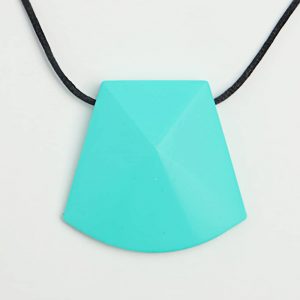
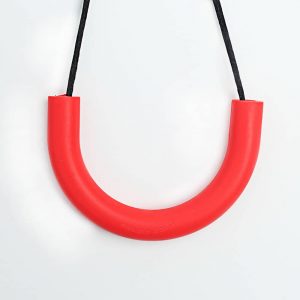
Next, you need to start thinking about what the child prefers to chew. And, where in their mouth they are chewing. This will help you to choose the most appropriate sensory chew toy for them.
How to choose between available sensory chew toys
By now you should be armed with a lot of information. This information will help you to consider the best option for your child. We will now explore suggestions for different preferences.
Safety considerations before you start!
One recommendation is to avoid cheaper alternatives for sensory chew toys
There are many suggestions online for inexpensive chew toy solutions such as aquarium tubing or straws. We understand why parents would prefer a less expensive option but are not happy to recommend these as it is difficult to know whether they are safe.
This is because, often, single use plastic products contain BPA. BPA stands for bisphenol A, an industrial chemical that has been used to make certain plastics and resins since the 1960s. Both the European Chemicals Agency (ECHA) and European Food Safety Authority (EFSA) agree that there is evidence that BPA has endocrine disrupting properties. This led them to the decision to strictly limit its use in food contact areas such as food and drink packaging. You can read more about BPA here.
We recommend only buying sensory chew toys, which have been specifically designed for children to chew on, from reputable companies.
Create a cleaning schedule
It’s important to make sure you wash the chew regularly. Most manufacturers have a recommendation on how their chews should be washed. As chews are not shared, usually hot soapy water is sufficient. Some can also go on the top shelf in the dishwasher.
Have a storage box for the chew
This can be a simple plastic container, but it’s helpful to encourage the child to put the chew into something when it’s not in use. This could be a plastic container on their desk. It doesn’t need to be fancy, it just needs to be a place they can store it. This helps for two reasons. Firstly, it’s easier to find. Secondly, and more importantly, it is more hygienic than the child just leaving the toy around on any surface.
Or use a lanyards
For some children a lanyard can help to keep the chew toy with them. Some parents also make their own using a piece of ribbon and a safety pin and affix the toy to the child’s clothing. It will really depend on the child’s individual needs. The commercial ones have a quick release clasp which are safest if the lanyard is around the child’s neck.
Match the sensory chew toy to how the child chews
If children chew at the back of their mouth
These children usually prefer a chew that has a longer stick shape. So, the P, I and X shaped sensory chews with longer arms can be a hit. Often these children prefer slightly harder chews.
When children prefer to chew or suck at the front
A rounder chew can be more suitable for these children. There are many different options with various textures. Often these children prefer softer chews and ones with a bit more flexibility. The ‘dog tag’ style can also be particularly good for children who like to suck.
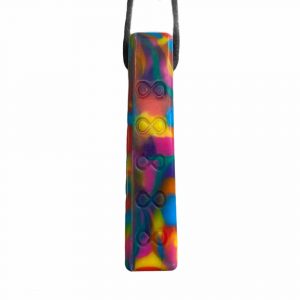
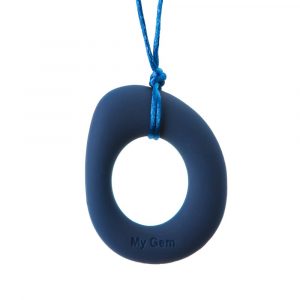
For children who chew everywhere their mouth
Look for a chew that has both a long and round part. The person shaped toys, for example, can be useful in this case as they have a rounder part at the head and longer parts at the legs and arms.
For children who eat through their sensory chew toys quickly
These children need a tougher chew. There is one called the ‘Chew Stixx Tough Bar’ which is the most robust we have found. The ‘Hexichew’ is also very robust. If you’re familiar with any others please let us know and we will add them to this list.
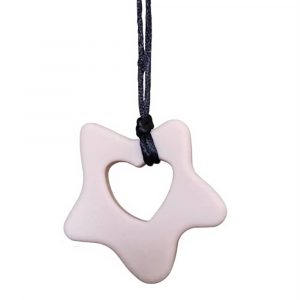
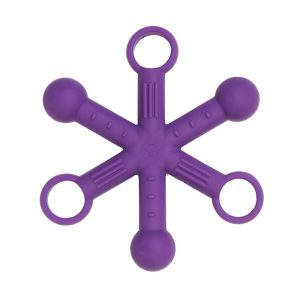
Sensory chew toys – Other options that are available
When material is preferred
Children who prefer the texture of material may reject a chew. It’s common that these children will also forget to use their chew and will just continue to chew on their clothing. A bandana tied around the child’s neck can be a good alternative for two reasons. Firstly, they can help to save clothing. Secondly, they can be changed as often as needed, which also stops the child’s clothing from being saturated.
Vibrating sensory chew toys
In some cases, vibration can be helpful for short periods. There is a product called the ‘ARK z-vibe‘ and also one called ‘VibraZilla’ which are very robust and designed for children. It is best to search using the specific terms or to look on sensory supplier websites. Otherwise, you can receive some very interesting search results!
Less ‘obvious’ sensory chew toys
Nowadays there are a loads of sensory chews that look like jewellery, one is called ‘chewlry.’ These are useful for children who don’t chew too heavily and those that suck. They tend to break quite quickly with children who chew heavily. Chewigem have a large range of bracelets and necklaces.

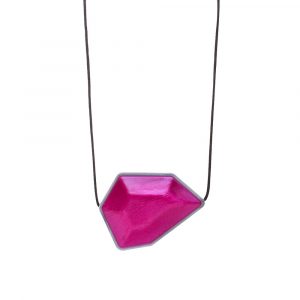
Getting creative with chewy pencil toppers
In addition, pencil toppers are available. These sit on top of a pencil and allow the child to chew the topper rather than the pencil. They tend to only work for children who are already chewing their pencil and for those that don’t bite down too hard. These can also be added to headphone cables or the ends of hoodie cords.
Alternatives to sensory chew toys
For older children, chewing sugar-free gum can be a great alternative. You may need to establish rules around using the gum. For example: ‘It must go into a tissue then into the bin’; ‘You must keep it inside your mouth’; and ‘No bubble blowing.’ Many children can manage this, especially if they find it is helping their concentration. Using two pieces of gum can also help, as it gives even more resistance during chewing. In addition, different chewy foods can be included at snack and meal times. Some examples of chewy foods include:
In conclusion
Whilst there are a huge number of sensory chew toys available, it is important to consider the best option for each individual child. There is no one size fits all solution. I hope the above tips are helpful when you are choosing a toy for your child. Don’t forget to share this article if you have found it helpful, and to join our mailing list to stay up to date with our newest posts.
Image credits
A huge thank you to Jenny and the team at Chewigem for providing us with the images for this post. You can purchase all of the products on this page here. Pleases note, this is not an affiliate link, Kim recommends these chews because she knows they are high quality!
Where to next?
If you wanted to learn more about proprioception you can ready this article Let’s talk about Proprioception – our hidden sixth sense!
To learn even more about the senses and sensory processing you can join our free introduction to sensory processing or you might like to purchase Kim’s newest book Success with Sensory Supports.
Heavy work can also help children who chew a lot to regulate we explore this further here The Mystery of Heavy Work

